
Shank
Will Leave a Rich Legacy of Scientific Leadership
Recovering Genetic
Identities From Primordial Slime
Shank Will Leave a Rich Legacy of Scientific Leadership
BY LYNN YARRIS
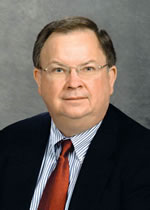 |
|
| Charles Shank |
He served as Laboratory director longer than anyone except for the Lab’s founding father, Ernest O. Lawrence. Now, after more than 15 years at the helm, Charles V. Shank, 60, is ready to pass the command on to a successor. Just as Lawrence steered the Laboratory through its transition from a tiny campus building to a sprawling, hill-spanning complex, so too did Shank steer the Lab through a major passage as it moved from its traditional leadership in high energy and accelerator physics to become a major player in the burgeoning fields of nanoscience, genomics and proteomics, computational research and astrophysics cosmology.
Shank, who became the Labo-ratory’s fifth director in September of 1989, announced on Monday, Feb. 9, his intention to step down from the position by the end of this year.
During his tenure, the Labora-tory’s annual budget climbed from $229 million to nearly $500 million, and the workforce grew to approximately 4,000. He presided over the construction of the Advanced Light Source, weathered its rocky adolescence, and helped manage its successful upgrade from a premier source of low-energy x-rays to a premier source of high-energy x-rays as well. He saw ground broken for the Molecular Foundry, an $85 million building that will be one of the focal points of the nanoresearch effort of the U.S. Department of Energy (DOE).
As director, he set the stage for relocating to our Lab the National Energy Research Scientific Comput-ing Center (NERSC), and negotiated with the directors of both Livermore and Los Alamos national laboratories to create the Joint Genome Institute (JGI), which played a significant role in the successful completion of the Human Genome Project. In a major departure from his own scientific background in femtosecond spectroscopy, he championed the Supernova Cosmology Project, which led to the breakthrough discovery of a mysterious force, dubbed “dark energy,” that accelerates the expansion of the universe.
Under his watch, the Lab participated in the discoveries of the top quark and neutrino mass, completed the Time Projection Chamber for the Relativistic Heavy Ion Collider and the front-end system for the Spallation Neutron Source, and finally began reclaiming the valuable land occupied by the long-defunct Bevatron.
There were disappointments, too, most notably the withdrawn claims for elements 118 and 116, but history is certain to judge his directorship a resounding success. Director Shank expressed pride in what has been accomplished during these past 15 years when he made his announcement.
“The opportunity to work with outstanding people in science at Berkeley Lab is unparalleled,” he said. “Through our work as a DOE Office of Science laboratory, we have made a great difference for the nation, opening new questions about energy in the universe, sequencing the human genome, developing nanoscience as a national endeavor, and achieving scientific discoveries through advanced computing. These advancements would not be possible without the dedicated support from the staff of the Laboratory, the University of California, and DOE.”
Many distinguished notables also expressed pride for the achievements under Shank’s directorship, and were lavish in their praise of his personal leadership.
Said Energy Secretary Spencer Abraham, “Throughout his tenure, Chuck Shank has provided scientific and managerial leadership at the highest standard of excellence at one of DOE's premier national laboratories. He is looked up to as a leader by his peers at DOE's 16 other labs — and respected by all those who have collaborated with him at DOE. He deserves great credit for Berkeley Lab's rich legacy of scientific leadership, major research results, and important scientific facilities since 1989."
Said UC President Robert Dynes, “Through his own scientific career and through his skilled management of the Lawrence Berkeley National Laboratory, Chuck Shank has made a major contribution to the cause of scientific advancement in this country. His leadership of Berkeley Lab for the last 15 years has played an important role in furthering the Laboratory’s reputation as one of the world’s leading centers of technological excellence. I deeply appreciate Chuck’s many contributions to the University of California, and I can say with certainty that his leadership will be greatly missed.”
One person in a unique position to comment upon Shank’s performance as Laboratory director is Martha Krebs, who served under him as an associate laboratory director, and over him as director of DOE’s Office of Science.
“Four characteristics have made Chuck Shank an effective and memorable Lab director: extraordinary scientific taste, determination, courage, and passion,” said Krebs, who now runs her own consulting firm, the Los Angeles-based Scientific Strategies. “His personal scientific breadth and his willingness to seek advice from the best people resulted in financial and programmatic expansion at the Lab when the overall DOE budget was not increasing. At the same time, he fought to sustain the excellence and vitality of the traditional Berkeley programs in high energy and nuclear physics, as well as the energy programs, which continue to make vital contributions to their national programs and beyond.
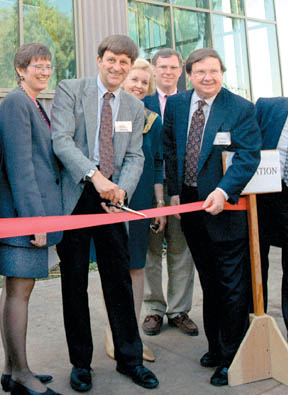 |
|
| Former Office of Science Director Martha Krebs (left), former Lab Director David Shirley, and Director Shank at the ALS ribbon cutting ceremony in 1993. | |
“His determination to keep Berkeley Lab at the forefront demonstrated itself at the level of building new programs and facilities, attracting the best staff, assuring that the ALS met its commitments to users, and advocating the Laboratory in the Washington, D.C. environment. In the face of increasingly detailed external management oversight, he supported the Laboratory staff in looking for best practices that were meant to be good for Berkeley Lab and for other laboratories, too. He didn’t hesitate to tell those of us in Washington when we were unhelpful or going in the wrong direction. He was diplomatic but always passionate on behalf of the Laboratory and what it took to make the Lab a great scientific institution.”
Shank’s departure announcement comes on the heels of DOE’s announced intent to hold a competition for Berkeley Lab’s management and operating contract. The current contract, scheduled to expire on Jan. 30, 2004, has been extended 12 months to provide sufficient time to conduct a competition that will result in an award by Jan. 31, 2005. Shank has stated his commitment to seeing the Laboratory through this competition, a commitment that was welcomed by UC President Dynes.
”I believe Chuck’s effective leadership, the tremendous accomplishments of the scientists at Berkeley Lab, and our own efforts to renew and reinforce management practices throughout the UC laboratory system have created a very strong competitive position,” Dynes said. “Assuming the UC Board of Regents does decide to participate in the competition, Chuck will play an important role in the competitive process.”
In the meantime, Dynes said UC will soon launch a search for Shank’s successor. An advisory search committee, named and chaired by Dynes, will include representatives from the UC Regents, Berkeley Lab, UC faculty, scientific institutes from outside UC, and others. The committee will review a list of candidates developed from nominations and applications solicited nationwide. The final selection of a new director will be approved by the UC Board of Regents based on Dynes’ recommendation. DOE must then concur with the appointment.
“I am confident that we will be able to secure a top-notch individual who will continue to foster the highest levels of excellence in the operation of Berkeley Lab, one of our nation’s scientific jewels,” Dynes said.
As the most senior of the DOE national laboratory directors in terms
of time served, Shank has earned a leadership mantle in Washington,
D.C. among his peers. He has become, in the words of Pacific Northwest
National Laboratory Director Len Peters, “the spokes-man for
the lab directors." His announced departure plans came as a sad
surprise.
”We will miss Chuck's combination of wit, bluntness, and the
ability to deliver a difficult message without offending anyone,"
Peters said.
In remembering Shank while she headed the Office of Science, Krebs said, “Chuck stood with the best of the national lab directors in recognizing that serving the national purposes of DOE required collaboration and competition for both scientific and management excellence. But he never lost sight that his primary job was to care for and advance Berkeley Lab. The Lab was fortunate to have him as its director.”
Recovering Genetic Identities From Primordial Slime
BY DAVID GILBERT
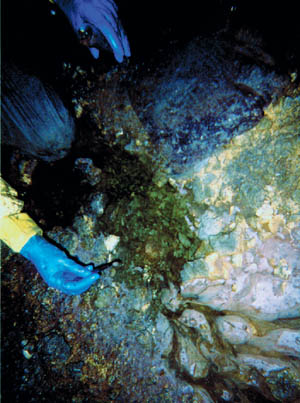 |
|
| The genomes of several microbial species were sequenced from this pink biofilm community, collected from acid mine drainage. |
Sequencing, or cranking out the exact combination of the four letters — A, T, C, G — that code for an organism’s idiosyncrasies, has become almost rote for gene jockeys. Scores of genomes have been completed, from bacteria to humans. The next big thing is to tackle metagenomes, or fleshing out the DNA of entire ecosystems in one fell swoop — which is what the DOE’s Joint Genome Institute (JGI) in Walnut Creek recently did.
In a study published in the Feb. 1 edition of Nature, JGI researchers reveal how the genetic identities of five microorganisms thriving in toxic conditions were recovered from a natural biofilm growing deep inside an abandoned copper mine at Iron Mountain, Calif. The process, in which the jumble of diverse DNA sequences from the quagmire is reverse-engineered to identity the critters that live there, requires enormous sequencing and computational horsepower.
“This is the first time we have managed to tease out genetic information directly from an environmental sample,” said JGI Director Eddy Rubin. Working with research-ers from UC Berkeley, led by Jill Banfield of the Lab’s Life Sciences Division, the JGI sequenced the constituents of a slick, gaudy pink biofilm collected some 1,500 feet below the surface in Iron Mountain’s Richmond Mine. Four of the five microbes sequenced in the biofilm have to this point defied laboratory culture and have only been studied in their natural habitat.
Decades of earthmoving activity at the Richmond Mine have created opportunities for microbes to colonize the site. The complex interaction of microbes, water, and exposed ore has generated dangerously high levels of sulfuric acid and toxic heavy metals that ultimately find their way into the upper Sacramento River ecosystem, which is why the mine is one of the Environmental Protection Agency’s worst Superfund sites.
Banfield’s team first applied the screening technique known as FISH (fluorescence in situ hybridization), a microscopic technique for a gross assessment of the microbial composition before sequencing at the JGI. A panoply of bacteria and archaea emerged, including those from the Lepto- spirillum and Ferroplasma genera which are implicated in mine leaching or acid mine drainage. Archaea are the remnants of an ancient group of organisms that bridge the gap in evolution between bacteria, prokaryotes, and the eukaryotes (organisms whose cells have a nucleus).
“We extensively sampled the genomes of the dominant members of one of the microbial communities we were studying. Our analyses of the assembled data have revealed a great deal about the population structure, as well as the nature of pathways central to survival of the microbial community,” said Banfield.
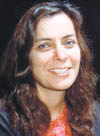 |
|
| Jill Banfield | |
“Microbes thrive literally everywhere on Earth, under all conditions, including extreme acidity, metal contamination and high radiation,” said Ray Orbach, director of DOE’s Office of Science, the primary sponsor of the work. “These studies will help us learn how microbes use inorganic materials as a source of energy that not only drives their cellular machinery but can also be used to clean up contaminated soil or water, capture carbon from the atmosphere, and produce potentially important sources of energy such as hydrogen and methane.”
By applying the shotgun sequencing strategy to the problem, information about these communities and their interactions with their environment is surfacing. Traditionally, DNA is isolated from a known target organism, but only about one percent of environmental microbes can be cultured in the laboratory.
“In the community sequencing approach, we extract DNA directly from the environmental sample, which can contain millions of diverse organisms, a veritable microbial ecosystem,” Rubin said.
Long strands of DNA bound up in the genomes of the mystery microbes are sheared into manageable pieces of approximately 3,000 bases, or letters. These pieces are fluorescently labeled and fed through sequencing machines to generate the exact order of nucleotide letters in their genomes. By employing JAZZ, a computational tool developed at the JGI for the assembly of genomes, the ends of these fragments are compared and the genomic sequence reconstructed, enabling species to be discriminated. Other algorithms identify the genes and their possible function.
“This work has provided a fascinating window into not only the diversity of the species involved, but their interdependency,” said Rubin. “And just as we have found in our studies of vertebrate genomes, the individual differences within those species are coming to light.”
David Gilbert is the public affairs manager for the Joint Genome Institute.
Shifting Landscapes Mark New Era in Lab History
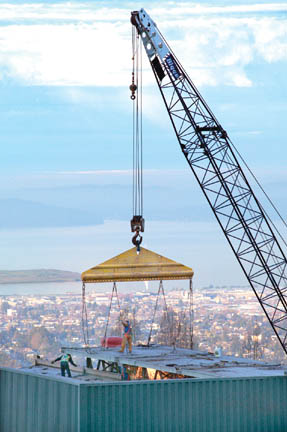 |
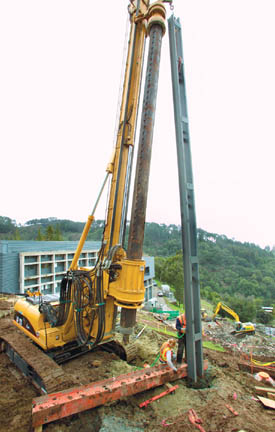 |
|
| A piece of history is lifted away as the deconstruction of the Bevatron began last month with the demolition of the old external proton beam (EPB) experiment hall. The industrial high-bay hall, a prominent landmark on the Hill since it was built in 1967 and used for storage following the Bevatron’s decommissioning in 1993, will be gone by the end of March. | One era in Lab history ends and another one begins as the Molecular Foundry rises on the slope between NCEM and Building 66. The $85 million, six-story building will house DOE’s national user facility for nanotechnology development and research. The building is expected to open in early 2006. Photo by Roy Kaltschmidt. |
On Being a Good Mentor
What does it take to be a good mentor? For starters: communication, communication, and communication. That was one of the messages conveyed last week when the Center for Science and Engineering Education (CSEE) held a workshop on mentoring undergraduate and high school students. The workshop was open to anyone interested in mentoring a student in one of CSEE's summer programs, in which Lab employees in scientific, engineering, and technical fields work one-on-one with students for 10 weeks. To give prospective mentors a taste of what to expect, CSEE head Rollie Otto and his colleagues discussed the principles of effective mentoring and revealed what former students say makes a good mentor.
“The most important part of my mentorship was the first two weeks — there was a lot of communication and I knew what to expect,” said a recent student in one of the mentoring programs.
Laurel Egenberger, head of CSEE’s college and university programs, added that communication runs both ways. “You have got to talk to the students. But listening is also important. Find out where they are and where they want to go.”
Other aspects of good mentoring include encouraging “what if” questions, being accessible, and including students in the decision making process. “If students feel they are a part of this organization for the summer, they are more likely to come back to the Lab for a large portion of their careers,” Egenberger said.
Most interns like to hit the ground running. Asked what they wish they had known about the internship before it began, some of them said in their evaluations: “I wish I had known more about the research that was taking place so I would be better prepared … I wish I had known the overall goal of the research conducted … I would like to have read some books of his work, and any nontechnical papers or articles.”
As for the mentors, the overwhelming majority agreed that the students made a contribution to their research and would recommend the program to their colleagues. When considering potential interns, Dale Koistinen, CSEE’s school tour coordinator, said that their desire to learn can be more important than past achievements.
“The most important thing is not what they know when they get here, but how motivated they are to learn,” he said.
2002 Mentor Awardees Honored
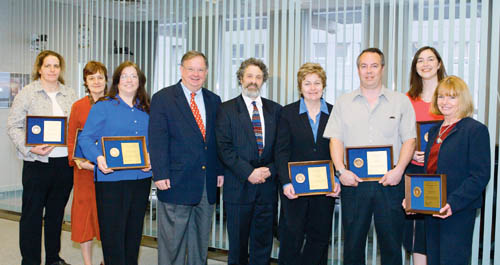 |
|
| Peter Faletra, the Office of Science associate director for Workforce Development for Teachers and Scientists, was unable to attend the June 2003 outstanding mentor award ceremony for the 2002 winners, so he took the opportunity to thank these mentors when he visited the Lab in early February. From left to right are Sharon Borglin, Lara Gundel, Kathleen Bjornstad, Director Charles Shank, Faletra, Ellie Blakely, Craig Wray, Jill Fuss, and Priscilla Cooper. (Not shown is Michael Siminovitch.) |
Each year, outstanding mentors are selected based on student evaluations and exemplary participation in programs provided through the Center for Science and Engineering Education. The Office of Science supports mentored research for undergraduate students and science, mathematics and technology teachers.
The Leading Edge of Science on Display at the AAAS
BY PAUL PRUESS
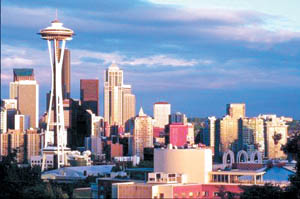 |
|
| The American Association for the Advancement of Science held its 2004 meeting in Seattle. |
Skies were sunny last week in Seattle, where the American Association for the Advancement of Science held its annual meeting. This year the theme at the nation's largest gathering of scientists and science users, policy makers, and communicators was "Science at the Leading Edge," and Berkeley Lab researchers — including Ashok Gadgil of the Environmental Energy Technologies Division, Jean Frechet and Enrique Iglesia of Chemistry, Saul Perlmutter of Physics, and Nigel Quinn of Earth Sciences — helped them live up to it.
The theme could have been Science at the Bleeding Edge. Outgoing president Mary Ellen Avery's kick-off address dwelled long and lovingly on the sense of magical possibilities encouraged in future scientists by the Harry Potter books, but elsewhere controversies were much on display. Participants disagreed about everything from health care and the environment to electronic voting. Even the definition of "weapons of mass destruction" came under attack, with bioterror specialist Barbara Seiders of Pacific Northwest National Laboratory remarking that "I personally am in violation of several international treaties by virtue of the contents of my refrigerator."
While engaging urgent topics, Berkeley Lab's speakers stayed above the fray. Frechet and Iglesia tackled the brave new world of nanotechnology. During a two-day "Nanotechnology Seminar," Iglesia discussed the nanoscale design of optimum metal catalysts. In a symposium on "21st Century Photonics," Frechet described molecules custom-designed at the intersection of light and electronics. Gadgil and Quinn contributed to a symposium on clean water technologies, with Gadgil presenting his UV Waterworks water purifier, and Quinn outlining a program for real-time monitoring of water quality in California's Central Valley.
Of two separate symposia on astrophysics and cosmology, the more engaging (and crowded) was Sunday morning's "Probing the Cosmos," organized by theorist Michael Turner of Fermilab. The symposium featured Perlmutter of the Supernova Cosmology Project and other observers who use gravitational lensing, the cosmic microwave background, and other arcana to gauge the history and future of the universe.
Turner was confident that the many seemingly isolated pieces of the cosmological puzzle would soon snap into one theoretical whole, just as the separate impressions of the blind men added up to an elephant. He quoted the late Soviet theorist Lev Landau: "Cosmologists are often in error but never in doubt."
"Whatever the big picture, it will be a surprise," Perlmutter remarked. "It could even come from a theorist, but we observers want to get there first."
The audience echoed persistent questioning that had been directed at NASA's Paul Hertz in an earlier meeting, when he conceded that NASA's cosmology experiments were on temporary hold. Noting that the forward impetus in cosmology could be derailed by NASA's decision not to service the Hubble Space Telescope, Turner said, "There will be no successor to Hubble for over a decade. We should be worried."
Worry was shared among many of the meeting's participants, in all fields. But for scientists, the adage that claims to be an ancient Chinese curse, "May you live in interesting times," is more like a challenge, promising plenty of fascinating problems at the leading edge in the months to come.
The Seismic Signature of Rock Fractures
sBY DAN KROTZ
 |
|
| San Andreas Fault | |
Earth Sciences Division researchers are learning how to read the seismic signature of shear stress on rock fractures, a development that could help scientists monitor the stability of fractures in boreholes and underground oil and gas reservoirs. And further in the future, their work could help seismologists gauge the accumulation of stress along active fault zones, one of the precursors to earthquakes.
“Monitoring shear stress is important because rocks generally fail under such stress,” says Aoife Toomey of Earth Sciences, who is studying the phenomenon with Seiji Nakagawa. “But up until recently there has not been a way to differentiate between the effects of normal stress and shear stress on a fracture. We’re working to make that distinction more clear.”
In a rock fracture — whether it’s the San Andreas Fault or a tiny fissure emanating from a borehole — shear stress acts parallel to the fracture, grinding the two sides against each other. The more shear stress applied to the fracture, the more the fracture opens up or dilates, which increases its instability and permeability. And if the stress continues to intensify, the more likely it is to fail.
Fortunately, determining whether a fracture is subject to shear stress became a little easier recently, thanks to laboratory experiments that reveal how seismic waves change when they cross a stressed fracture: P waves, which move like a slinky, convert to S waves, which move in an S shaped pattern, and vice versa, even for normally incident waves. When detected on the surface and within boreholes, these anomalous wave conversions yield insights into the magnitude and direction of the shear stress, and provide a window into monitoring the stability of fractures.
To gain an even better understanding of how these wave conversions yield clues about stressed fractures, Toomey and Nakagawa are using numerical models to simulate mode-converted waves. Their work is enabling them, for the first time, to develop a quantitative relationship between converted waves and a fracture’s geometry, seismic frequency, and in-situ shear stress.
So far, their simulations have revealed that fracture dilation —
one of the indications of likely failure — is accompanied by
a significant increase in the amplitudes of converted waves. When
the waves spike, the fracture is dilated and shear stress is high.
“Possible applications of this phenomenon include ensuring the
stability of fractured reservoirs during fluid production and injection,
or mapping the distribution of permeability in a reservoir,”
says Toomey.
In addition, because lab experiments have shown that dilation is a precursor to the failure of a fracture, their research could give scientists a tantalizing clue about the stability of a fault. For example, if the amplitude of a fault’s converted waves increases, perhaps it is ready to rupture. However, much more research is needed before such earthquake prediction becomes a reality.
“We need to know if converted waves are produced at the lower frequencies used in the field,” Toomey says. “But even if our work is not feasible for earthquake prediction, it could someday be used in civil engineering to analyze the stability of manmade structures such as bridges.”
Duct Sealing Comes Home
BY ALLAN CHEN
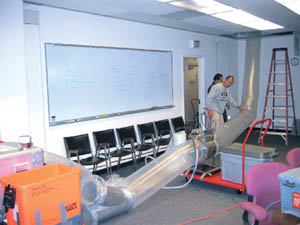 |
|
| A room in Building 90 is having its ducts sealed with an aerosol-based technology developed by scientists at Berkeley Lab. |
Building 90, the home of the research group that developed an aerosol-based method of sealing ducts to save energy, is now having its own ducts sealed by the very process invented here at Berkeley Lab.
The aerosol sealing process, developed by Mark Modera and his colleagues in the Environmental Energy Technologies Division (EETD), was commercialized by Berkeley Lab and is now licensed to Carrier-Aeroseal. The company has been training contractors for several years in the use of the duct sealing technology. The duct sealing process is available to homes in many parts of California and in other states. More than 10,000 homes have been sealed to date.
More recently, a new atomizer technology, developed by EETD’s Duo Wang and Modera, has made it possible to seal the ducts in commercial buildings, expanding the market for the sealing process. Carrier-Aeroseal licensed this technology as well and improved its performance further with new sealing control techniques.
The duct sealing of Building 90 began in early December, and almost all of the work was completed by the holiday shutdown. The only sealing remaining to be performed is for the vertical shafts, scheduled to be completed within a month. This sealing was the first full-scale test of the new atomization and control technologies, which were found to seal approximately 10 times faster than the original sealing technology tested in Building 90 in 1998.
The research on the duct sealing technology began in the early 1990s, when EETD research showed that many homes were losing 20 to 40 percent of the hot or cold air running through their duct systems — a large and unseen waste of energy that costs the U.S. $5 billion annually. Modera’s team developed a solution, and Modera began a start-up company called Aeroseal to commercialize the technology. Aeroseal was acquired by Carrier Corporation in 2001.
For more information about the research, see: http://epb1.lbl.gov/EPB/aerosol/index.html.
‘There's a time for every organization to undergo revitalization’
Shank on Lab, Legacy, Life
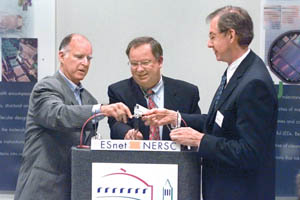 |
|
| Director Shank (middle) is joined by Oakland Mayor Jerry Brown and Jim Decker of the DOE for the dedication of the Oakland Scientific Facility. | |
It was a surprise to most employees that “Chuck,” as most call him, chose to leave, and at a time when uncertainties loom for the University of California’s management contract for Berkeley Lab, which will be competed for the first time in history.
Not to worry, said the Department of Energy’s elder statesman, at 60 among the longest-serving Laboratory leaders. He will see the Lab through its contract challenges. During an interview with The View this week he reflected on this and other topics.
View: Why now? What led to your decision to step down at this
time?
Shank: As a matter of principle, I think that there’s
a time for every organization to undergo revitalization. I’m
very pleased with where the Lab is now, and I think it’s good
to have a new leader take it to the next level. The time for me to
give my very best was the past 15 years. I feel good about passing
the baton to someone else, someone who can stand on the shoulders
of those who have gone before, and develop the future.
My decision to do this came well before the contract competition [was announced]. However, the fact that it was announced made me realize that it was very important for me to see that competition through. It is then a natural time to change leadership.
View: What do you think the search committee should look for
in a new director?
Shank: I think the University needn’t look for a replica
of me. But were I to choose, I would want to select someone who, first
and foremost, is excited about the mission and the science, excited
to learn new things and accept challenges. The most sustaining single
thing for the lab director is to draw energy from the challenges and
pursue them with all the vigor he or she can muster.
The person should be recognized throughout the country as a scientist
and a leader. Past directors of this lab have all met that standard.
It will be important to have someone who respects and nurtures the
Lab partnerships with the Berkeley campus while expanding interactions
across the University. And it is imperative to be able to deliver
on expectations — of the Department of Energy, the Berkeley
campus, and the UC system.
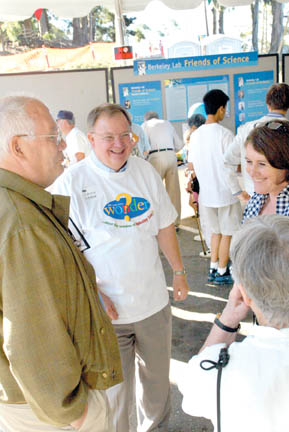 |
|
| Director Shank mingles with visitors at Open House 2002. |
Although it is not necessary that the person know about the DOE — this was confidently told to me when I accepted the job — I have come to realize that the act of understanding and appreciating how organizations work make you far more effective.
View: What can you tell us about the upcoming competition
for Berkeley Lab’s contract?
Shank: The Congress of the United States has spoken. Our Lab
management is being competed. The goal is a noble one, to assure that
after 50 years, the management of this lab is providing the best return
for the U.S. government. Having said that, we are in a unique position
among all the labs that have ever been competed in the history of
the DOE.
Our laboratory was approved for contract negotiation and extension. We were within a hair’s breadth of having a contract in place with the DOE. It’s a wonderful position to be in for those engaged in a contract competition when the DOE has already made a public assessment of work performance. Nonetheless, it is important for us to create a transparent process and a level playing field that will encourage all potential bidders to evaluate an opportunity to manage this lab.
It is also my view that there is a high likelihood that no other institutions would be willing to invest the capital to actually compete with the University. High likelihoods are not a certainty, and as a consequence, we are engaging the process with sufficient vigor that if a competitor were to emerge, the outcome could not be in doubt.
View: What are the most notable moments that you recall about
the last 15 years?
Shank: First and foremost is the closure of the Bevatron, which
occurred just as I began as director. Now I look out my window and
see the Bevatron being dismantled. It marked the end of an era and
brought home to all of us the need for a transition. The challenge
we faced when I arrived was, “what would that future be?”
Fortunately, I stood in the shadow of my predecessor (David Shirley),
who created the opportunity for the Advanced Light Source, which is
today a world-class facility, engaging the Lab, campuses, and the
whole world in cutting-edge science.
We also faced the challenge of launching the Human Genome Project, which was something quite new for the Lab and for biology — a biology project of a scale that had never been attempted. I’ll never forget reading an article in which a biologist said the human genome project was a task best done in a penal colony, not in a research laboratory. It is with great satisfaction that I saw the genome project start a revolution in biology. We kept our commitment, delivering the genome sequence of chromosomes 5, 16 and 19 efficiently and on time. And the future of the Joint Genome Institute is currently redirecting from human sequence to understanding creatures in the biosphere. This project, this future, will open up an understanding of life on this planet in ways that none of us can imagine today.
It was also very exciting to bring Daniel Chemla aboard and watch him pioneer the field of nanoscience, which culminated in the establishment of the Molecular Foundry.
We’ve seen the Laboratory embrace computing as a tool for scientific discovery. And with the operation of the NERSC (National Energy Research Scientific Computing Center) computing facility, our Laboratory is making impacts that are appreciated around the world.
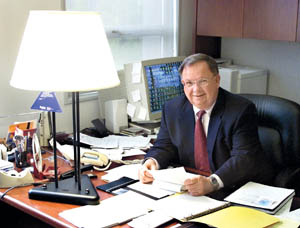 |
|
| The Berkeley Lamp debuts on Director Shank's desk in 2001. | |
View: Where have you been most challenged during your tenure?
Shank: For someone whose formative years were spent in the
private sector, understanding and nurturing the partnership with the
DOE was a major challenge. We have seen oversight of our Laboratory
move from somewhat antagonistic to constructive, based on a shared
sense of integrity for both institutions. I am deeply appreciative
of the DOE’s support and the creation of scientific programs
that have enabled our Lab to flourish.
Another challenge was to understand the importance of listening to and addressing the concerns of our stakeholders and critics. It is important that the Laboratory breathe in the passion of those who are fearful and critical of our enterprise in order to build the support we will need for the Lab to survive. Every major project at this Lab begins with the view that nothing is possible, nothing can happen, unless a miracle were to occur, and we at the Lab have witnessed many miracles.
View: What is ahead for this Laboratory, and what will you
leave to your successor?
Shank: I believe the Lab has accomplished a transition to a
broad portfolio of scientifically interdependent activities. Although
these thrusts at first blush may appear to be independent and abstract,
it is in fact one of the great values the Lab brings in creating new
science at the boundaries of disciplines. Our Laboratory is well down
the path of creating opportunities from our diverse strengths, and
it is this skill and view of the world that I believe will solidify
the position of this Lab in facing its future.
View: What is ahead for you professionally after leaving the
Laboratory?
Shank: All of my efforts and energies for the last 15 years
have been directed toward only this Lab and its success. When I pass
the baton on to the next director, I will open my thought processes
to my future, which is currently a work in progress.
View: And how will you spend your time away from the office,
in your post-laboratory life?
Shank: I think I contemplate reengaging science creatively.
I’ve learned so many things in the last 15 years that I know
that whatever I pursue scientifically will be greatly influenced by
that. I also plan to draw a few deep breaths of clean air and contemplate
life as a fully engaged human being.
Lost at Sea But Not Forgotten
BY MONICA FRIEDLANDER
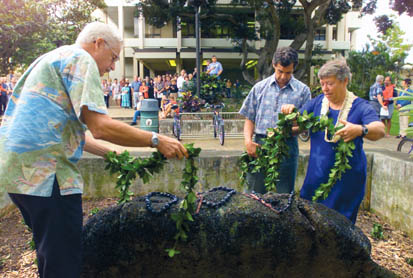 |
|
| The memory of the 10 missing crew members was honored during a ceremony at the University of Hawaii Marine Sciences Building. Placing leis at the memorial are Ted Murphy of the Pacific Biomedical Research Center (left), Joyce Miller of the Joint Institute for Marine and Atmospheric Research, and Bob Rocheleau of SEA Engineering, Inc. |
The mystery surrounding the disappearance of a research vessel off the coast of Hawaii continues a quarter century after the Holoholo was lost at sea. But those who perished in December of 1978 — including two Berkeley Lab scientists — were never forgotten, and their memory was honored on Jan. 23 with the dedication of a memorial garden at the University of Hawaii’s Marine Sciences Building. Also aboard the ill-fated craft were researchers from the University of Hawaii and from the National Oceanic and Atmospheric Administration, plus a crew of three.
Lab physicists James Carl Sandusky and Stephen Shannon of the Earth
Sciences Division (ESD) were part of the research expedition working
on the Ocean Thermal Energy Conversion project (OTEC), which was funded
by the Department of Energy and run by the ESD under contract with
the University of Hawaii. The scientists were planning to take measurements
in the waters off the coast of Hawaii to determine the feasibility
of producing electrical power utilizing differences in ocean water
temperatures.
On Dec. 9, 1978, the vessel left Snug Harbor, near Honolulu, and was
due to arrive two days later at Kawaihae Harbor on the island of Hawaii,
where they were to pick up three more researchers. But radio contact
with the 94-foot craft was lost after it sailed off, and the Holoholo
never reached its destination. The Coast Guard and the Navy began
an extensive search over a 19,000-square-mile area, hampered by gale
force winds of 35 to 40 knots. Four planes were dispatched, all to
no avail. The search was suspended after four days. No trace of the
ship and its crew was ever found, other than a wooden current meter
box.
The two scientists from Berkeley Lab were particle physicists who had just shifted careers and joined the Marine Sciences Group in Earth Sciences to work on the ocean thermal conversion program. Sanduski, 32, had worked at the Lab for four years and had already gone on a previous research cruise to Hawaii. Shannon, 35, had been at the Lab since he joined as a graduate student in 1966.
Heading the project and the division at the time was marine geologist and oceanographer Pat Wilde, who was planning to sail on the ill-fated mission himself.
“I was scheduled to go on the second Holoholo cruise, but I was needed at a meeting at that time, so Jim and Steve represented Marine Sciences on that cruise,” Wilde recalls, saddened by the memories. “Jim was a very hard working individual and had the courage to shift gears professionally. Steve, who never really worked for us, was intelligent and, like Jim, saw that a career change was desirable.”
The traceless disappearance of the Holoholo triggered a flurry of controversy and speculation about its fate, complete with rumors of classified missions, kidnappings, and Russian spy satellites. A month after the boat vanished, the U.S. Coast Guard and the National Transportation Safety Board held a hearing in Hawaii to try to determine the cause of the tragedy. The inquiry attributed the accident to weather conditions and failure by the vessel’s owner to follow certain safety procedures.
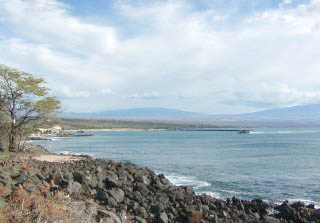 |
|
| The Holoholo never reached its destination at Kawaihae Harbor (above) | |
The flat-bottomed boat was not a research vessel but a converted private yacht owned by one of the old Hawaiian families, Wilde recalls. It was intended as a pleasure craft (its name means ”Let’s go out and have some fun”), not for open ocean sailing. A lawsuit by the families against the University of California and the University of Hawaii (which chartered the boat) was settled in Hawaiian courts.
The tragedy, however, did not sink the oceanography project, which ran until 1986. “We continued the OTEC programs and actually had more cruises to that site and other sites worldwide,” says Wilde, now retired.
Colleagues and family members of the University of Hawaii scientists on the Holoholo who participated in the ceremony on Jan. 23, remembered their own: Gary Niemeyer, Michael Allen and Robert Harvey.
Dave Karl, an oceanography professor at the University of Hawaii who worked with the committee to dedicate the memorial, said the mission was performing “very important research for Hawaii and the nation.” He added that those who mourn the loss of the 10 young men are “still haunted” by the lack of a clear explanation for this tragedy.
But their memory will live on, and so will their quest to understand and befriend the ocean, which tragically and ironically took their lives.
Berkeley Lab View
Published every two weeks by the Communications Department for the employees and retirees of Berkeley Lab.
Reid Edwards, Public Affairs Department head
Ron Kolb, Communications Department head
EDITOR
Monica Friedlander, 495-2248,
msfriedlander@lbl.gov
ASSISTANT EDITOR
Lyn Hunter, 486-4698 LHunter@lbl.gov
STAFF WRITERS
Lyn Hunter, 486-4698
Dan Krotz, 486-4019
Paul Preuss, 486-6249
Lynn Yarris, 486-5375
CONTRIBUTING WRITERS
Jon Bashor, 486-5849
Allan Chen, 486-4210
FLEA MARKET
486-5771, fleamarket@lbl.gov
Design & Illustration
Caitlin Youngquist, 486-4020
TEID Creative Services
Berkeley Lab
Communications Department
MS 65, One Cyclotron Road, Berkeley CA 94720
(510) 486-5771
Fax: (510) 486-6641
Berkeley Lab is managed by the University of California for the
U.S. Department of Energy.
Online Version
The full text and photographs of each edition of The View, as well
as the Currents archive going back to 1994, are published online on
the Berkeley Lab website under “Publications” in the A-Z
Index. The site allows users to do searches of past articles.
Flea Market
- AUTOS & SUPPLIES
-
‘03 TOYOTA COROLLA CE, 8K mi, warranty, maint rec’s,
exc cond, at, airbags, ac, am/fm/cd, $11,450, Saito, 643-3374
‘98 FORD ESCORT SE SEDAN, 4 dr, 68K mi, exc cond, serv rec’s, ac, am/fm/cassette, elec win & locks, cruise, pwr steer, airbags, $4,100, Nadine, X5868
‘95 TOYOTA VAN PREVIA, 88K mi, good cond, turbocharger, exc for mountains & families, $10,000/bo, Ed, X6047
‘95 NISSAN ALTIMA GXE, 4 dr sedan, 70K mi, at, ac, cruise, alarm, clean cond, $3,500, Chih-Wei, X5265, 704-8249
‘93 VW FOX, $1,000, 90K mi, ac, recent smog, mech sound, some dents, Paulo, 486-5626
‘89 HONDA ACCORD, 2 dr coupe, white, 5 sp, 80K mi, good cond, new tires/battery/windshield, many upgrades, $1,700, Will, X5689, 522-7024 - HOUSING
-
ALBANY, 2 bdrm/1 bth house, freshly painted, fp, fenced yrd w/ fruit
trees, lge storage shed, gardener incl, lge kitchen, dw, refrig,
gas stove, w&d, nr Solano Ave & El Cerrito Pl, avail now,
1st mo rent + $1,000 dep, no smok/pets, Ilan, 526-4007
ALBANY,1 bdrm condo, Gate View Apt’s, 555 Pierce St, avail 2/15, unfurn, very clean, new carpet, exc cond, all util pd, 1 car parking in sec garage, wheelchair access, view, storage, pool, tennis ct, gym, coin laundry, 24-hr dec, refrig, stove, dw,12-mo lease, $1,250/mo + $,1500 sec dep, Mary, X4701, 816-9702
BERKELEY HILLS, furn suite by the week/mo for visitors to UCB/LBNL in modern priv home, eleg, spacious & comfortable, bay views, can walk to UCB, gfchew@mindspring.com, Geoffrey, 848-1830
BERKELEY HILLS, 2 bdrm/1 bth, priv entr, priv deck, priv bthrm, hardwd flrs, lge common area w/ counter & sink, centr heat, offstr parking, shared w&d, very lge garden w/pond & waterfall, panoramic view 5 bridges, no smok/pets, all util include, $1,600/mo, Paul, X5051, 549-3788
BERKELEY HILLS, beautiful house w/ bay view, fully furn, 3 bdrm/1 bth, lge kitchen, liv rm, & din rm, priv yard w/ roses & fruit trees, garage, parking space, 1 blk to Grizzly Peak & 1 min walk to pub trans, nr LBNL & Tilden Park, Direct TV, $2,500/mo incl garbage, water & gardening, no smok/pets, avail 4/1, Jenny, 649-7638 zhengyix@yahoo.com
BERKELEY HILLS, fully furn rm w/sep entr, full kitchen privil, w&d, quiet neighbrhhd, loveley backyard, next to bus stop, avail now, $850/mo incl util, labartists@aol.com, 524-3851
BERKELEY, 2 bdrm/1 bth fully furn home, family friendly neighbrhd, nr N Berkeley BART/stores/restaurants/I-80 /UC, $1,800/mo, avail 4/1, Julianna, (636) 279-2070, lopezfoundas@yahoo.com
BERKELEY, beautiful 1 bdrm/1 bth home, close to UC/BART/grocery shopping, high ceilings, newly rebuilt, double pane windows, sec alarm, cable & internet ready, avail now, $1,300/mo, 1-yr lease, short term neg, Tony, X7624, 849-3146, laxsmio1@comcast.net
BERKELEY, Carleton/Grant, nr BART/ shops/Lab shuttle, close to LBNL, newly renov 2 bdrm apt, ground flr of 2 story Victorian house, sunny southern exposure, front garden, w&d, custom tile flrs, no smok/pets, $1,400/mo, incl part utils, avail 3/1, Richard or Hope, 845-1723
BERKELEY, HEARST COMMONS ,1146-1160 Hearst, studio townhouses w/ decks, hardwd flrs, skylights, dw, ac, sec, wired for cable/sat, Ian, 548-1831, $795/mo, hearstcommons@jps.net for pictures
DOWNTOWN BERKELEY, fully furn, sunny lge studio, indep kitchen w/ lge table-desk, avail 3/1, Geoffrey, 800-455-3863
HERCULES, 3 bdrm/1 bth, newly modeled, lge yard, garage, close to school, prk, shopping & express bus to BART, $1,795/mo + dep, no pets, Betty, 245-7517 or 643-4889
KENSINGTON, quiet 2bdrm/1.5 bth home, avail 4/1 - 8/1, full furn, lge yard, bay view, wooden flrs, w&d, parking, close to Kensington Village, shopping & bus, nr UC, small car avail to lease, $2,000/mo + dep, non smok, Todd, 642-6090 days, 559-3951
NORTH BERKELEY HILLS, 1 bdrm, 1 person garden apt w/ fp, off Grizzly Peak Blvd, 1 blk to pub trans, 3 mi to Lab, 5-10 min walk to Tilden Park, avail 2/15, $950/mo incl util & laundry, no smok/pets, 1st+last+sec $250, Barbara/Bill, 524-5780 8 am – 9 pm
NORTH BERKELEY HILLS, 2bdrm/1 bth house, elec kitchen w/ dw & disposal, quiet street, charming & priv, park-like yard, sep din rm, fam rm w/ fp, extra lge mastr bdrm, bdrms & liv rm open to deck, overlooks yard, bay view, dog run, carport, walk to bus, nr campus, Keeler Ave @ Shasta, $2,200/mo, dep $2,200, more for pets, yr-lease neg, (530) 587-6411, 848-3836 message, melton@usamedia.tv
NORTH BERKELEY HILLS, bay view, 3 bdrm/2bth lge furn house, lge yard, quiet Grizzly Peak location, walking dist to Lab, DSL & wireless internet, owner on sabbatical, avail 3/1-10/04 to a LBNL visiting scientist or prof, looking for someone to take over the house or room in the house, vgo@pacbell.net
NORTH BERKELEY HILLS, furn house sublet, 2 bdrm/2bth, avail immed for 2-1/2 to 4 mo, nr LBNL, serene leafy setting, fenced yard, hardwd flrs, pets welcome $1,780/mo, Susan, 841-4889
NORTH BERKELEY HILLS, unfurn studio, $725 rent + $725 dep, carpet & Spanish tile, garden exposure, priv ent, kitchenette, laundry, single person occup, no smok, no wheelchair access, street parking, Larry, 524-7610, morrison_l@netzero.net
NORTH BERKELEY, lge & sunny, fully furn, 1/1 Victorian flat, laundry, gated carport, walk to Lab shuttle/UCB, by week, mo or semester, gfchew@mindspring.com, Geoffrey, 848-1830
NORTH BERKELEY, 1 bdrm, quiet, Grant betw Cedar & Virginia, close to LBNL bus, furn, deck, 4unit house, offstr parking, Gordon, 548-9869, shellymandel@comcast.net
PLEASANT HILL, 3 bdrm /2 bth house on cul-de-sac, central air, ceiling fans in every rm, remodeled kitchen, fp, new gas stove, garden window in kitchen, close to downtown, freeway access, $1,850, 1st + last mo + dep, Ron, (925) 207-4255, dmattia@lbl.gov, also interested in selling at $455,000 by owner, call for appt - HOUSING WANTED
- FEMALE seeks house to share in Alameda/ Orinda/Lafayette or other small, peaceful town in the area, non-smoking, quiet & responsible person, rent outright or work/trade, Christina, 865-0863, clonzisero@hotmail.com
- MISC FOR SALE
- ELECTRIC WHEELCHAIR, powerful Invacare Pronto M71 power wheelchair
w/ SureStep technology, barely used, like new, exc maneuverability,
stylish, great stability, comfort & control, drives over thresholds
up to 2", one of the best on market, $4,000/bo (new $5,500),
Jo, 652-0372
FOLDING POCKET KNIFE, Benchmade "Bali-Song" Model ATS-34, new $79, sell for $40, Fred, X4352
KENMORE, freezer, 60x28x29, $200/bo, Mina, 486-4365, MJBissell@lbl.gov
WEBER GRILL, 18" used one season, good cond, $40, Fred, X4352, 282-2831
WOMEN’S SUBURBAN BIKE, $160, Subur-ban/Schwinn, 26”, comfort, shimano equipped, 21 sp, almost never used, very good cond, Nadine, 841-1716 - FREE
- 14" COLOR MONITOR, 3-Diamond Viper V770, video cards w/ software, Steve, (209) 832-5042, X2525
- OTHER
- NEW EMPLOYEE OUTDOORS ACTIVITIES club is being organized at LBNL for employees to enjoy the Bay Area environment and connect w/ colleagues. Activities considered incl hiking, backpacking, camping, jogging, running, etc. First meeting will take place on a hike/picnic lunch, Sunday Feb 22, at 11 am @ Inspiration Point-Tilden Park, email ddlevy@lbl.gov
- VACATION
- LAKE TAHOE house, 3 bdrm, 2-1/2 bth, fenced yard, quiet, sunny,
skiing nearby, views of water & mountains, $195/night, 2 night
min, Bob, (925) 945-9345
Flea Market Policy
Ads are accepted only from Berkeley Lab employees, retirees, and onsite DOE personnel. Only items of your own personal property may be offered for sale.
Submissions must include name, affiliation, extension, and home phone. Ads must be submitted in writing (e-mail: fleamarket@lbl.gov, fax: X6641,) or mailed/delivered to Bldg. 65.
Ads run one issue only unless resubmitted, and are repeated only as space permits. The submission deadline for the March 5 issue is Friday, Feb. 26.
Chakraborty Joins Engineering Academy
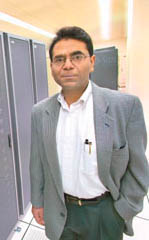 |
|
| Arup Chakraborty |
Berkeley Lab materials scientist Arup Chakraborty is one of 76 new members and 11 foreign associates recently elected to the National Academy of Engineering (NAE). Election to the NAE is among the highest professional distinctions accorded to an engineer and honors those who have made "important contributions to engineering theory and practice, including significant contributions to the literature of engineering theory and practice.”
Chakraborty holds joint appointments with the Lab’s Physical Biosciences and Material Sciences Divisions and with UC Berkeley’s departments of chemistry and chemical engineering. He was recognized by the NAE “for the application of theoretical chemistry to practical problems, including immune system recognition, polymer interfaces, sensor technology, and catalysis.”